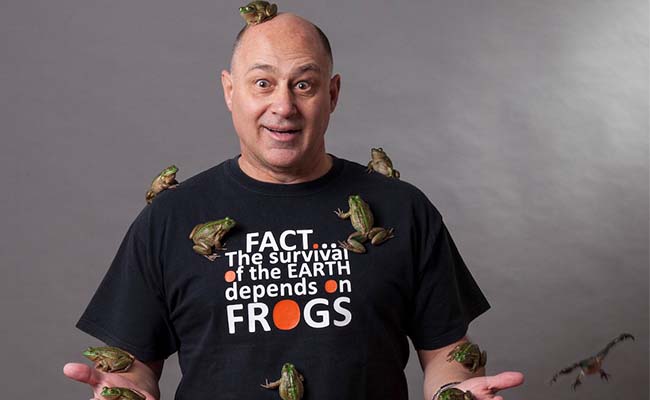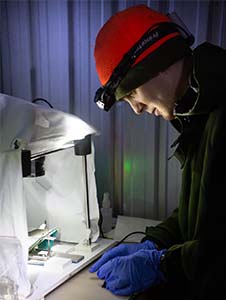Friday 15 October 2021 7:55am

A new species of endemic frog, Bishop’s frog Leiopelma bishopi, has been named in recognition of the late Professor Phil Bishop (1957–2021).
A new species of endemic frog discovered from fossils in North Canterbury has been named in recognition of the late Professor Phil Bishop (1957–2021) for his services to worldwide amphibian research and conservation.
The new species, Bishop’s frog Leiopelma bishopi, has been described in a paper published in The New Zealand Journal of Zoology by Dr Nic Rawlence and Dr Luke Easton, in collaboration with Alan Tennyson from the National Museum of New Zealand Te Papa Tongarewa.

Dr Luke Easton
Lead author, Dr Luke Easton who undertook the research as part of his PhD, says the finding is significant as it’s the first record of Leiopelma frogs from the eastern South Island and from the Pliocene period that to date has been a major gap for understanding the evolution of New Zealand’s frogs. Leiopelma frogs are a genus of primitive frog only known from New Zealand.
“The finding and naming of Bishop’s frog bridges an important knowledge gap between the Miocene 16-19 million years ago and the bones in caves around New Zealand from late Quaternary which spans the past 20,000 years,” Dr Easton says.
“Due to this poor fossil record, discoveries like Bishop’s frog show that New Zealand may have a rich unknown fossil frog record.”
Bishop’s frog is ancestral to the native frogs still present in New Zealand today, including Archey’s, Hochstetter’s, and Hamilton’s frog, which are regarded as some of the world’s most ancient frogs.
Co-author Dr Nic Rawlence of the Otago Palaeogenetics Laboratory, says what makes this new finding particularly interesting is that living populations and fossils of Leiopelma frogs are only known from wetter, forested regions of the country.
“The fossils were found in what is now semi-arid North Canterbury which is not somewhere you would expect to find a frog today given their preference for wet forest,” Dr Rawlence says.
“This suggests North Canterbury was forested and wetter during the Pliocene 3.7-2.4 million years ago, and that the subsequent extinction of frogs in this region is likely due to increased aridity following uplift of the Southern Alps and cooling associated with the Ice Ages that followed.”
Professor Phil Bishop was at the forefront of amphibian conservation biology both in New Zealand and internationally, having arrived from the United Kingdom to start his position as Senior Lecturer in the Department of Zoology in 1997.
With over 100 publications in conservation biology and applied ecology, his research has contributed broadly from Aotearoa’s little-known native frog species to the development of conservation techniques and approaches globally.
“I cannot thank you enough for honouring Phil in this special way. He would be extremely proud to have his legacy perpetuated in this way, as are Adam, Luke and I. We appreciate it very much and no words can describe how much it means to us."
Professor Bishop was one of Dr Easton’s PhD research supervisors, and he remembers Phil as not only a great scientist, but also as a mentor, supporter, and friend.
“One of the stand outs for me is how he treated his students like we were part of his whanau,” Dr Easton says. “This meant that we could always be honest and open with each other, and we always felt comfortable with expressing our feelings to him.”
“I also owe my ability to perform in my role to Phil as he taught me the tools that I needed,” Dr Easton says, who now works as a Biodiversity Ranger for the Department of Conservation.
Prior to his passing earlier this year, Professor Bishop learned of the finding of this new frog, and the research team obtained the blessing of Phil, his wife Debbie, and their two sons Adam and Luke, to name it Leiopelma bishopi in his honour.
“We really wanted to name a new species after Phil as a tribute to his services to frog conservation worldwide and especially in New Zealand,” Dr Rawlence explains.
Professor Bishop’s wife, Debbie Bishop, says she is humbled and extremely grateful to both Dr Rawlence and Dr Easton for their hard work and dedication in producing this extraordinary paper on this new species of Leiopelma.
“Naming this ancient frog Leiopelma bishopi in honour of Phil is an incredible tribute to his dedication in promoting, conserving and saving this amazing group of amphibians,” Mrs Bishop says.
“I cannot thank you enough for honouring Phil in this special way. He would be extremely proud to have his legacy perpetuated in this way, as are Adam, Luke and I. We appreciate it very much and no words can describe how much it means to us."
Kōrero by Guy Frederick, Sciences Communications Adviser
